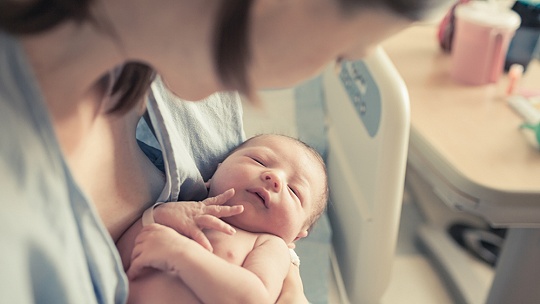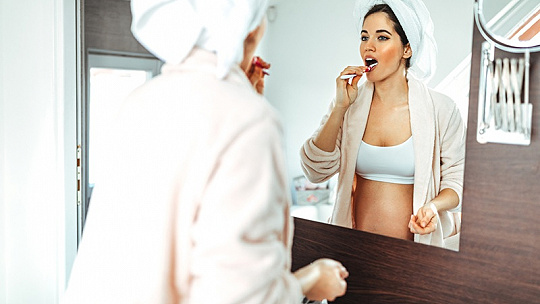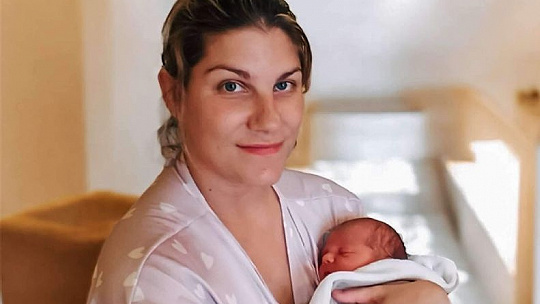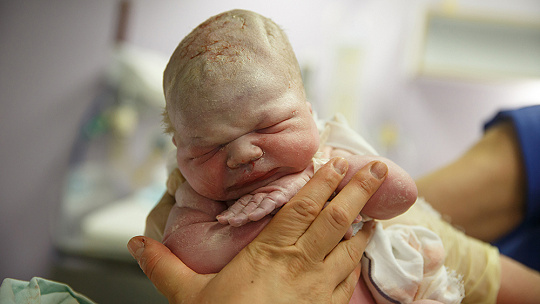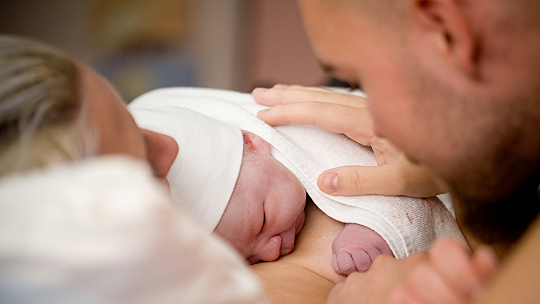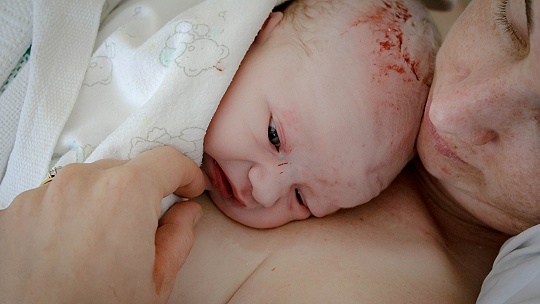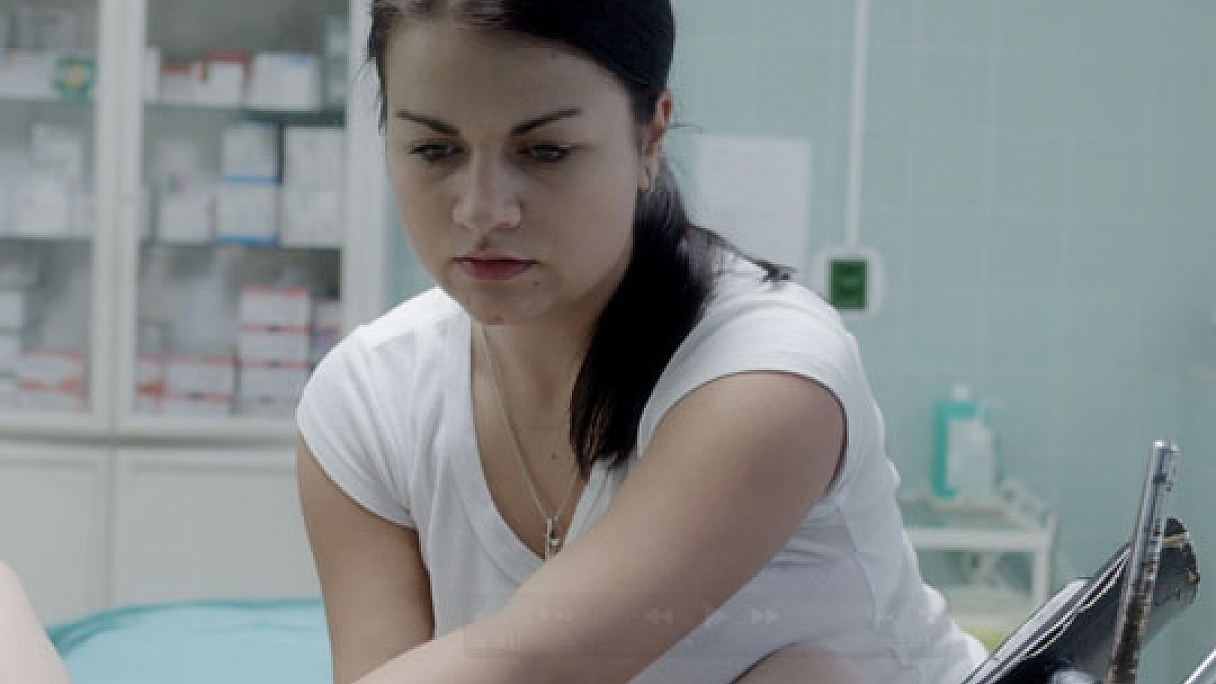
Rodíme! Dieťa je naše... A kde zostala matka?
Foto: Medzi namiŽena ako telo, ktoré jej nepatrí. Pozrite si ukážku z filmu Medzi nami:
It Is the Woman to Give Birth, Not the Medical Personnel, An Activist Stresses from Selina Becker on Vimeo.
Nedôstojná a neosobná starostlivosť sa schováva za rúšku profesionality. Rodiaca žena je redukovaná na ležiace telo, ktoré už ani nepatrí jej. Patrí personálu, ktorý s ním rutinne narába podľa svojich potrieb. Vyvlastnenie ženského tela je umocnené slovami adresovanými členke personálu: „Renátka, rodíme!“. Informácia nie je teda určená žene, je určená personálu. Množné číslo „rodíme“ prenieslo aktivitu rodenia zo ženy na personál.
Personál prichádza, nepredstavuje sa. So ženou sa nikto nerozpráva, iba dostáva pokyny, ako sa má napolohovať tak, aby poloha vyhovovala personálu. Hierarchicky vyššie postavená lekárka inštruuje nižšie postavenú, ako má viesť nástrih hrádze. A to v čase, keď žena ešte ani nezačala tlačiť. Súhlas s nástrihom však ležiacemu telu nie je adresovaný. Je predsa jasné kto rodí, kto rozhoduje. Žena tlačí proti sile – leží na chrbte, v najhoršej možnej polohe, preto „ zatlačíme!“. MY. Telo nemá ani meno: „Netlačíte, MOJA!” povie žene členka personálu. A tak spoločne tlačia, žena tlačí a personál tlačí žene na brucho. Bez súhlasu vykonáva škodlivú praktiku. O jej rizikách nepadne ani slovo – personál pomáha, to musí žene ako informácia stačiť. Dieťa sa narodí a prvé slová: „Dobre! Už je NAŠE!“ rozširujú vyvlastnenie aj na práve porodené dieťa.
Ak by sme chceli prepísať túto scénu tak, aby bola v súlade s medzinárodnými odbornými štandardami a zobrazovala by dôstojnú a rešpektujúcu starostlivosť, museli by sme zmeniť prakticky všetko. Museli by sme zo scény vyškrtnúť 8 ľudí, zmeniť direktívne správania sa personálu, škodlivé postupy zmeniť na dobrú prax. No v prvom rade by sme museli zmeniť postoje – žena nie je „moja”, dieťa nie je „naše” a pôrodná asistentka žene asistuje. Nerodí za ňu ani spolu s ňou.
V súlade s dobrou praxou by pôrodná asistentka poskytovala tzv. one to one care, čiže starostlivosť jednej pôrodnej asistentky o jednu ženu. Ležiace telo by sa zmenilo na aktívne rodiacu ženu, ktorá by mala dostatok času vytlačiť dieťa (u prvorodičky môže tlačenie trvať aj viac ako dve hodiny), a to v polohe, ktorú by si slobodne zvolila. Počas celého pôrodu by sa slobodne hýbala, namiesto rutinného nástrihu by dostala teplé obklady a po pôrode by jej pôrodná asistentka vytvorila priestor, aby si sama alebo s jej pomocou priložila dieťa na hrudník. Pôrodná asistentka by rešpektovala práve zrodenú rodinu a dopriala by rodičom dostatok času, aby sa zvítali so svojím dieťaťom.
Ing. Zuzana Krišková, PhD., predsedníčka občianskeho združenia Ženské kruhy a spoluautorka publikácie Ženy – Matky – Telá, www.zenskekruhy.sk
Film Medzi nami je dostupný už aj na internete. Pozrieť online aj stiahnuť si ho môžete TU.
Vzdelávacie turné s filmom Medzi nami a expertkami môžete podporiť na StartLabe.
Publikáciu Ženy – Matky – Telá o právach žien pri pôrode si môžete stiahnuť bezplatne TU.
It Is the Woman to Give Birth, Not the Medical Personnel, An Activist Stresses
How would our babies be born if best practice medicine were followed? Every day during the International Week for Respecting Childbirth we bring you an excerpt from our documentary Before I Met You, accompanied by expert commentary. Today, human rights activist Zuzana Krišková of the civil association Ženské kruhy (Women´s Circles) writes about how the language and the attitude of the medical staff during birth are important, too.Undignified and impersonal care is hidden behind the veil of professionalism. The woman giving birth is reduced into a lying body that no longer belongs to the woman: it belongs to the staff that routinely handles it according to their needs. The expropriation of the female body is enhanced by the words addressed to a staff member: „Renátka, we´re delivering.“ The information, in fact, is not intended for the woman, it is intended for the staff. The plural form in „we are delivering“ transferred the activity of giving birth from the woman to the medical personnel.
The staff approaches but they do not introduce themselves. Nobody talks to the woman, she only receives directions on how to position herself so that she better suits them. The hierarchically superior physician instructs the subordinate doctor on how to perform episiotomy, and all that takes place at a time when the woman did not even start pushing. However, the approval of episiotomy is not addressed for the lying body, as it is clear who is delivering, who decides. The woman is pushing against the force, lying on her back, in the worst possible position, so we hear „We push harder!“ WE. The body does not even have a name: „Push! You´re not pushing DARLING“ says a staff member to the woman. And so they push together, the woman is pushing and the staff is pressing the woman´s abdomen, performing a harmful practice without her consent. There is no word of the risks associated: the staff is helping, this clearly must be sufficient information for the woman. The baby is born and the first words „Good! The baby is OURS!“ extend the expropriation further on the child that has just been born.
If we wanted to rewrite this scene to comply with international professional standards and show a dignified and respectful care, we would have to change practically everything. We would have to remove 8 people from the scene, change the directive conduct of the staff, and turn the malicious procedures into good practice. In the first place, however, we would have to change attitudes: the woman is not „darling“, the child is not „ours“ and the midwife assists the woman. She is neither delivering for her nor with her.
In accordance with good practice, the midwife would provide one to one care, i.e. the care of one midwife for one woman. The lying body would turn into a woman actively giving birth that would have enough time to push the baby out (firstborns may even take more than two hours of pushing) in a position the woman would freely choose. She would be able to move freely throughout the birth, instead of routine episiotomy, she would receive warm pads, after giving birth, her midwife would create room for the woman to lay the baby on her chest herself or assisted by the midwife. The latter would respect the newly-born family, and would give the parents enough time to welcome their child.
Ing. Zuzana Krišková, PhD., chairwoman of the civic association Ženské kruhy and co-author of the book Ženy – Matky – Telá (Women—Mothers—Bodies),

